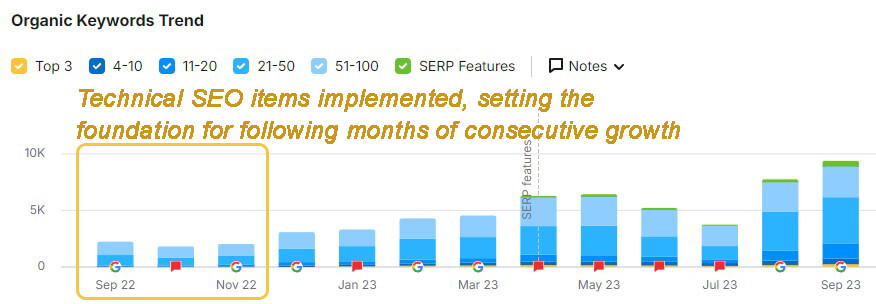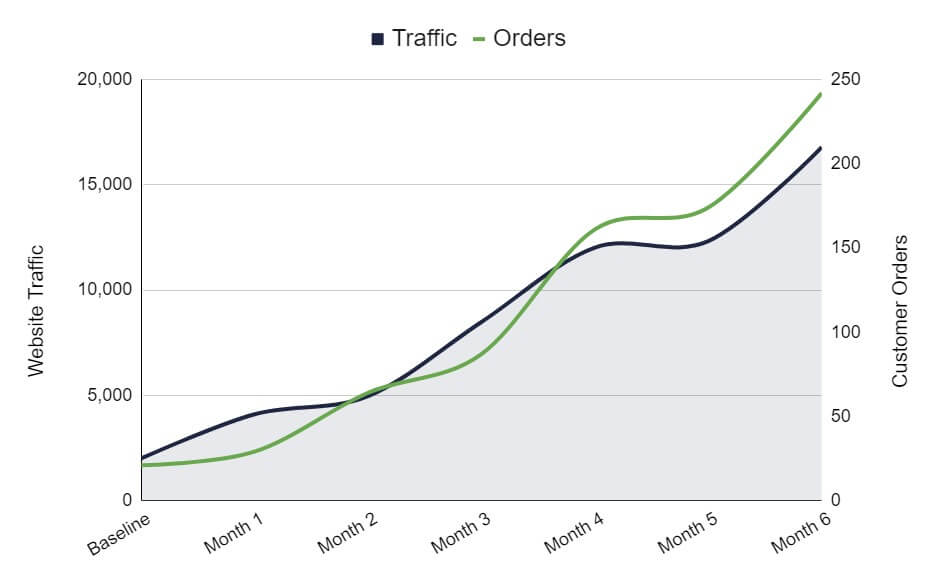+740% in Website Traffic
11.5X in Order Volume
+3258% in Revenue
The Problem
A family-owned business, traditionally reliant on word-of-mouth and referrals, developed a website to expand into online contact lens sales. Despite having strong products, fulfillment systems, and excellent customer service, they lacked a marketing plan to effectively scale their online presence and reach a broader audience.
TechAudits Strategic Approach
We developed a custom strategy for this brand including technical SEO, content, and user experience to emphasize their strengths and operate within their workflows. We focused heavily on crawler accessibility, content coverage and clustering, CTAs and the conversion funnel, and bolstering E-E-A-T signals by highlighting their qualified staff.
The Results
We were thrilled with the results achieved for this online contact lens seller, a family-owned side project that, within six months, was considering significant investments and a full-time commitment to the business. The exponential growth in traffic, sales, and revenue was remarkable, but the real impact came from increasing the lifetime value of their customers. By aligning our strategy with their brand goals and emphasizing exceptional customer care, they were able to foster customer loyalty and drive repeat business, leading to sustained success.
*Data in this case study consists of real numbers from our customer’s CRM and analytics platforms. For privacy reasons, we do not disclose the brand name in this case study.
Partnership Details
Brand + Awareness
This partnership consisted of the mixed scope of brand and awareness TechAudits offerings. After alignment discussions to understand the brand’s goals, we focused mostly on the Awareness portion within the first 6 months covered in this case study. To start the engagement, tech SEO and EEAT were primary focuses to solidify the foundation of the website and highlight the expertise they had on staff. A mid-scale content strategy, schema, analytics and various audits followed. This resulted in truly putting their business on the map and in competition with big name brands in just 6 months.
Implementations
- Full content strategy and production, focusing on a balance of topics by search intent throughout the buyer’s journey.
- Enhanced analytics tagging to feed site health and performance dashboards.
- Crawlability and indexation optimization, including information architecture (IA) revision
- Full domain image and video optimization initiative
- Global and page-level schema markup
- Several site template redesigns
See how TechAudits can grow your business.
Get started with managed SEO services today.
THE STORY
Understanding the Business
We believe that growth stems not just from data, but from a compelling story, a strong brand, and a clear message. To unlock this company’s potential, we first immersed ourselves in understanding their business—its history, goals, strengths, challenges, unique selling points, and previous marketing efforts that succeeded or failed.
Activities included in this phase of our process included:
- New client intake form
- Brand discovery calls
- Meeting with various stakeholders throughout the business to understand unique perspectives
- Vision, mission, and purpose definition
- Review of previous campaigns and initiatives
- Brand SWOT analysis
Brand Building
One of our main goals coming out of this discovery phase was to strongly solidify this client’s name as a brand people recognize and trust, which of course is beneficial in organic performance as well. Some of these activities began towards the end of our first 6 months and carried on after, but included:
- Bolstered authorship on the website with eyecare professionals
- Increased transparency in brand/website operations and QA
- Highlighted brand and employee credentials
- Expanded content coverage in core areas that customers care about
- Solicited and highlighted genuine customer reviews
- Establish a presence in other channels such as social media platforms and YouTube
Comprehensive Website Audits
This deep knowledge allowed us to contextualize the data we gathered. With a solid grasp of the brand’s identity, we began auditing the website from all angles, including technical SEO, user experience, and content.
From this analysis we were able to create a prioritized list of issues and opportunities to blend with performance data and business goals to create a roadmap. That roadmap consisted of a healthy mix of technical SEO fixes, content expansion, template optimization, and user experience enhancements. This was planned intentionally to spread our efforts across all aspects of the website to show continuous improvement and spend our resources on the most impactful items.
Technical SEO
From our various technical SEO audits, we were able to work with their team to fit priority items in their queue and make significant improvements. There were a few items, however, that we were not able to get pushed through due to resourcing constraints – and that’s okay. We were able to adapt and get several key items implemented, including:
- Main navigation update
- Global schema optimization for article, organization, webpage, and product
- Internal linking improvements
- Image compression, alt text, sizing, and schema
- Video descriptions, hosting optimization, and schema
- Key page meta element optimization
- Sitemap reorganization
- other various page-level enhancements
Immediately from these optimizations, we began to see ranking keyword growth for our existing content.

Data Source: SEMrush
Content Strategy
Alongside implementation of the technical SEO requirements for the website, we audited the content on the website and began crafting the new content strategy. Previously, there wasn’t much of a strategy being followed. On the ecommerce side of the website, the product pages were created as suppliers released new items and contained only the bare minimum information. The site did have an articles section, which they called “news” because that was the default label within the website template they had used. However, it operated as more of a blog.
Upon auditing these sections, we discovered clear content issues such as:
- Competing content, keyword cannibalization
- Duplicate published content
- Thin content
- Excessively long pages, lacking a core topic
Ultimately, the content within this section contained great material from experts in the field, but it wasn’t organized or formatted in a way to allow it to perform.
We were able to marry the brand knowledge we obtained with audience research to develop a content calendar that effectively accounted for search intent (informational, consideration, and transactional), relevancy, topic clustering and hierarchy, and user journey stage. We were able to work with the client team to understand their capabilities for generating quality content from their expert staff and devised a plan to provide them with the right type of content briefs to be most efficient and effective. Simultaneously, we worked with their developer teams to:
- Optimize core site templates to structure content
- Create backend custom fields to push E-E-A-T signals, highlighting their experience
- Create page layouts to streamline publishing
We began publishing this content around the first “Dec 1” you can see in the traffic chart below. As you can see, this new and optimized content instantly started to gain traction with search engines.

Data Source: SEMrush
User Experience (UX)
With this brand, it was really about capitalizing on the little traction and momentum they had and scaling it fast. With that as the goal, it was essential to gradually implement a healthy balance of all aspects of strategy in our recommended changes to the site. Technical SEO sets the foundation to be able to perform, content strategy expands the brand’s reach to attract and assist high quality traffic – but none of that will matter with a poor user experience that prevents users from engaging and converting.
The user experience on the website when we started with this brand wasn’t terrible. It was just rather out-of-the-box wordpress type navigation with little to truly guide the user throughout the website. We aligned with our client up front that everyone was open to more drastic changes, which we mixed in with smaller updates to improve UX. We later worked together on conversion rate optimization (CRO) efforts including some A/B split testing, however we agreed that within our first 6 months we wanted to get the website up to date on best practices before that.
Some of the items that we were able to help the client implement included:
- Full homepage redesign guidance
- Product details page (PDP) template redesign guidance
- Product listing page (PLP) template redesign guidance
- Main navigation update
- Website section migrations to establish a more effective information architecture – this included splitting out the “news” section into a guided “learn” section of the site with educational articles as well as an “industry updates” section for product launches and notices
- Custom template design guidance for new sections of the website
- Significantly expanded standard product attributes to incorporate more information on product pages
- Added an in-article secondary navigation, highlighting different types of media such as infographics and video
We were able to measure the success of these changes through various metrics including time on page, scroll depth and clickmaps (thanks to the client having hotjar installed on their site), and several conversion funnel metrics.
Ultimately, our combined program goals were focused around conversion metrics – since that determined their ROI and true business impact. We saw significant growth across the board, such as new customers, average order price, repeat customers, and of course total revenue. You can see total order volume in the chart below, scaling from just 21 orders when we started (which was their highest month to date) up to 242 unique customer orders in month 6. At the same time, we increased the average order volume from just over $80 to over $195, leading to 33.6X monthly revenue.

Data Source: Customer’s ecommerce platform, Google Analytics
Outcomes Prove ROI and Lasting Value
This is a story that we particularly love. The TechAudits team has worked with many enterprise-level brands, including names up to Fortune’s top 100. That of course has its advantages in terms of resources, funding, and ability to scale where it will make the most impact. But this wasn’t a Fortune 100 brand. This was a family owned local business that historically took the back burner to their in-person optometry practice.
Through our partnership and collaboration, we were able to put their brand on the map together and transform their website into a legitimate revenue driving portion of their business.